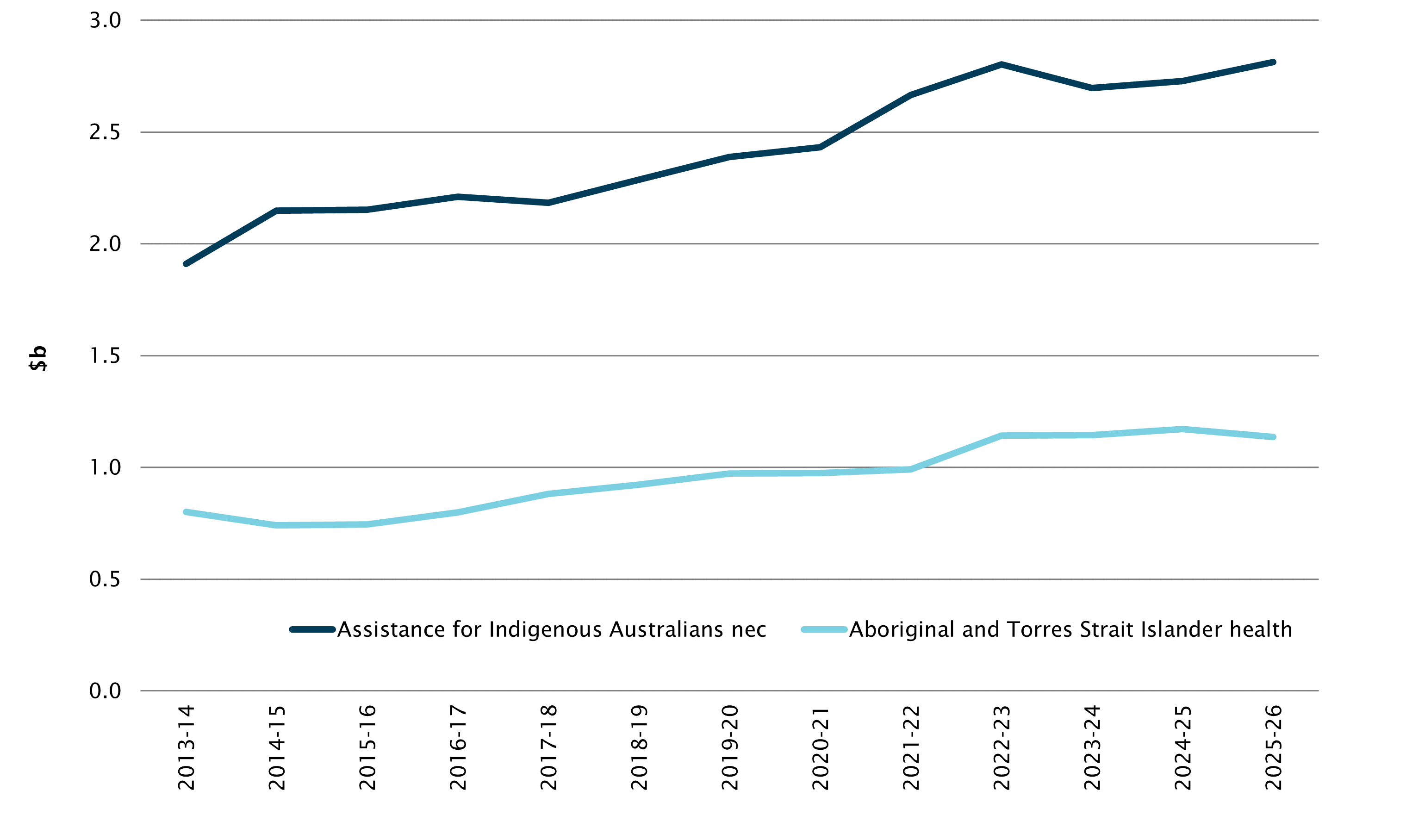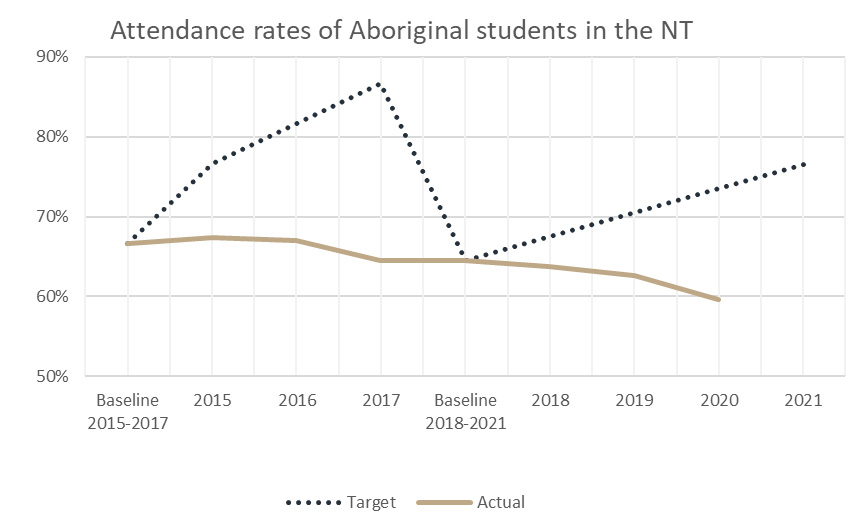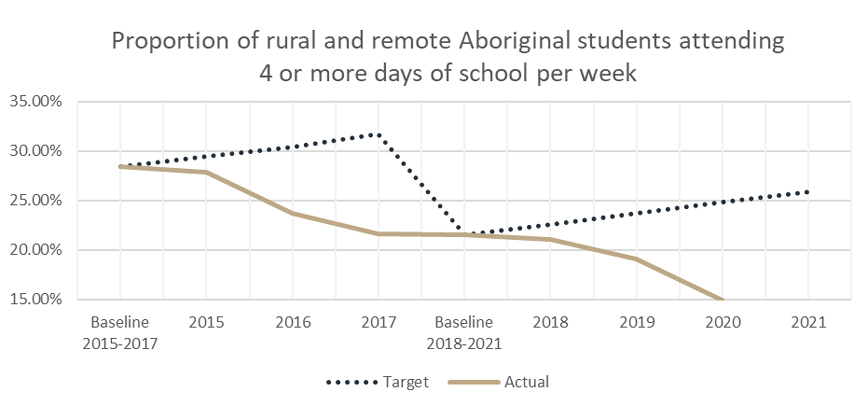Budget Review 2022–23 Index
James Haughton
The Budget Review articles on Indigenous Affairs summarise
and contextualise Indigenous-specific measures across portfolios. This article covers
measures related to leadership, land, economic development and education, while
a
separate Indigenous affairs article covers measures relating to health,
culture and language, housing, justice and safety. These categories have been
chosen to align with the Budget and elements of the new Closing
the Gap Priority Reforms and Targets.
Unless otherwise stated, all page references are to Budget
measures: budget paper no. 2: 2022–23.
Overview of budget trends

The 2022–23 Budget continues an apparent trend of increasing expenditure on
Indigenous-specific Commonwealth programs under the Morrison government, after constant
or slowly increasing expenditure levels under the Abbott and Turnbull
governments. This is in part driven by the temporary response to COVID-19, but
is also due to increased Commonwealth investment under the new Closing the Gap
framework, particularly measures announced on
5 August 2021 with the release of the Commonwealth’s
Closing the Gap Implementation Plan. The trend in the budget function
‘Assistance for Indigenous Australians nec [not
elsewhere classified]’ (Budget
Strategy and Outlook: Budget Paper no. 1 2022–23, pp. 154, 158)
is shown in Figure 1. This figure includes programs delivered by the National
Indigenous Australians Agency (NIAA) under the Indigenous Advancement Strategy
(IAS), expenditure by Indigenous-specific government corporate entities such as
Indigenous Business Australia, the Indigenous Land and Sea Corporation and the
Torres Strait Regional Authority (excluding inter-agency transfers), as well as
a number of National Partnership payments. Expenditure against this function has
consistently increased over the last 3 budgets, as has the budget function for
Aboriginal and Torres Strait Islander Health (Budget
strategy and outlook: budget paper no. 1: 2022–23, pp. 151, 154).
However, these increases are partly offset by the Commonwealth’s withdrawal
from funding Indigenous-specific housing (not included in these aggregates).
Source: Prepared by the
Parliamentary Library from previous budget papers. Figures are nominal (non-inflation
adjusted) dollars reflecting actual spending in that year except for those from
2022–23 onwards, which are projections from current Budget Paper 1.
Expenditure on these Indigenous programs is currently
projected to flatten over the forward estimates, reflecting the projected end
of the National Partnership on Northern Territory Remote Aboriginal Investment
(NTRAI). However, the recent
announcement of a 2-year extension of the NTRAI indicated that other investments
in remote Northern Territory communities would take its place, suggesting that
this flattening may be more apparent than real.
Leadership and governance
The Budget includes several measures intended to strengthen Indigenous
leadership, decision-making power and capacity. These are in line with the Closing
the Gap Priority Reforms to boost shared decision-making and strengthen
community-controlled organisations.
$31.8 million is provided in 2022–23 in the Indigenous
Voice – Local and Regional Voice Implementation measure to ‘commence establishment
of 35 Local and Regional Voice bodies’ (p. 161) in line with an option
presented by the Indigenous
Voice Co-design Process Final Report. The Minister’s
media release announcing this response states, ‘for the Indigenous Voice to
work, it must have a strong foundation from the ground up’, presumably
explaining why no funding or framework has yet been announced for a National
Voice. Having 35 regions would correspond to the number of former
ATSIC regions, which are still the basis for the Australian
Bureau of Statistics’ Indigenous statistical geography.
$3.0 million will be provided over 2 years from 2021–22 to
support Aboriginal Peak Organisations Northern Territory (APONT) to work with
the Australian Government and Indigenous Australians to develop a strategy for
future investment in the Northern Territory (p. 156). This is in line with a NTRAI
review recommendation (p. 9) that ‘future arrangements should provide
Aboriginal representatives a role as shared decision-maker in the design,
delivery and monitoring of policies and programs which are delivered to their
communities’. Funding for this measure has already been provided.
$37.5 million is provided over 5 years for the Future of
Prescribed Bodies Corporate measure to build the capacity of the Registered
Native Title Prescribed Bodies Corporate (RNTBCs) sector (p. 160), of which
$6.6 million is new money and the remainder is to be met from the IAS budget. Increased
funding and capacity-building for RNTBCs has been frequently called for by the
sector, particularly in response to legislative changes affecting RNTBCs such
as those proposed for the Corporations (Aboriginal and Torres Strait
Islander) Act 2006 in a
recent review, or those introduced by the Native Title
Legislation Amendment Act 2021 (Bills
Digest). The Senate
Legal and Constitutional Affairs Committee inquiry into that Bill received
numerous submissions about the lack of resources for building governance capacity
faced by the sector (Committee
report, pp. 46–47).
Also likely related to these calls and reports is the $21.9
million measure Strengthening Indigenous Leadership and Governance (p.
165, see also the Government’s media
release) which provides $13.5 million for the Australian Indigenous Mentoring
Experience (AIME); $6.7 million for the Office of the Registrar of
Indigenous Corporations (ORIC) to develop governance training materials for
Indigenous organisations; and $1.7 million to the NIAA to provide scholarships
for Indigenous Australians to undertake company directors’ courses, and
monitoring and evaluation.
The National Native Title
Council welcomed the increase in RNTBC capacity building funding, but
expressed disappointment that there was no ongoing secure funding for the
sector. The native title sector is also likely to be disappointed that the
government has not acted further on reforms to the Native Title Act 1993
and RNTBCs suggested by the Australian
Law Reform Commission or the Taxation of
Native Title and Traditional Owner Benefits and Governance Working Group Report
to Government, which would strengthen not only the governance but also
the bargaining and financial position of RNTBCs.
Land
The centrepiece of the Indigenous budget is the Indigenous
Rangers – Capacity building measure (p. 161), which provides $636.4 million
over 6 years (of which $322.4 million is over the current forward estimates) to
expand the Indigenous Rangers program. The measure promises to fund up to 1,089
new full-time equivalent (FTE) ranger positions and 88 new ranger groups,
expand women and youth rangers programs, and set up an Indigenous Land and
Water Management body. The Indigenous Rangers program currently has a budget of
$102 million annually (with ongoing funding of this amount announced
in March 2020) and employs
898.7 FTE positions (at 9 April 2021) consisting of over 2,100 full-time,
part-time and casual rangers. This new funding roughly doubles the existing
funding per year, meeting longstanding calls
from stakeholder group Country Needs People and matching a commitment
by the Australian Labor Party. As well as positive
outcomes for employment and the environment, a recent
Australian Institute of Health and Welfare (AIHW report) found Indigenous Ranger programs promote Indigenous
mental health and reduce suicide risk, a priority
of the Morrison government.
Measures to improve the governance of native title-holding
Prescribed Bodies Corporate are noted above. As RNTBCs currently hold some form
of native title over 3,321,982
square kilometres, or approximately 43.1% of Australia’s land area, their
capacity for effective governance is a key element of land management.
The Budget also announces $74.4 million over 9 years,
already provided for, for partnerships with Traditional Owners in the Great
Barrier Reef (p. 57) and a package of $26.8 million, of which $16.2 million is
new money, under the Supporting the Management of Commonwealth National
Parks measure (p. 57). Most mainland Commonwealth
National Parks are owned by Traditional Owners and rented by Parks
Australia. The package includes $10.6 million to increase Traditional Owner
engagement, employment and traditional knowledge conservation. This measure was
announced
on 9 March 2022 in response to a
critical report finding that Parks Australia had lost the trust of
Traditional Owners.
The Aboriginal and Torres Strait Islander Land and Sea
Future Fund (ATSILSFF), which provides funding to the Indigenous Land and Sea
Corporation to acquire land and water for Aboriginal and Torres Strait Islander
people, has had another good year. For the year ending 31 December 2021, the
ATSILSFF achieved a return of 10.7% against a benchmark of 5.5%. The total
capital of the ATSILSFF was valued at $2.2 billion at the end of that year (Budget
paper no. 1, p. 331).
Economic development and employment
Aside from the Rangers measure, the major employment-related
measure in the Indigenous budget is further supplementary funding of $98
million in 2022–23 for Community Development Program (CDP) providers to meet
increased demand (p. 156). CDP
participant statistics for the COVID-19 pandemic period have recently been
released (see Table 1 and Figure 2 below). These show a significant increase in
participant numbers in response to the COVID-19 pandemic and resulting changes
in Jobseeker payments and CDP penalty regimes. Also notable is the rapid
drop in participant numbers when financial penalties for non-participation in
CDP activities were re-imposed in early 2021, until penalties were
again removed on 12 May 2021.
Table 1 Summary of data on
CDP participation and financial penalties
| CDP Quarter ending |
Participants |
Participants w vulnerability |
Total Financial Penalties (n) |
| Sep-18 |
23,929 |
1,411 (6%) |
43,680 |
| Dec-18 |
26,058 |
1,691 (6%) |
46,544 |
| Mar-19 |
24,542 |
1,852 (8%) |
35,282 |
| Jun-19 |
25,251 |
2,270 (9%) |
31,821 |
| Sep-19 |
25,431 |
2,539 (10%) |
30,544 |
| Dec-19 |
28,299 |
3,030 (11%) |
27,181 |
| Mar-20 |
29,638 |
3,338 (11%) |
22,872 |
| June-20 |
37,958 |
3,509 (9%) |
266 |
| Sep-20 |
39,166 |
3,376 (9%) |
0 |
| Dec-20 |
40,469 |
3,581 (9%) |
6,783 |
| Mar-21 |
35,718 |
3,392 (9%) |
30,764 |
| June-21 |
34,681 |
3,459 (10%) |
11,361 |
| Sep-21 |
34,964 |
3,477 (10%) |
np |
| Dec-21 |
38,565 |
3,785 (10%) |
np |
Source: NIAA, Community Development Program Quarterly Compliance Data. Some data is not published (np) but appears to be
below 20
Figure 2 CDP participants and financial penalties over time

Source: NIAA, Community Development Program Quarterly Compliance Data. Some data is not published (np) but appears to be
below 20.
In a related measure, the Remote Engagement Program
measure (p. 164) provides $11.5 million over 5 years from 2021–22, of which
$4.7 million is new money and the remainder is from the IAS budget, to continue
piloting the Remote Engagement Program (formerly the Remote
Jobs Program), which will replace the CDP on 1 July 2024. This measure also
provides funding for legal fees and grants agreed by the Commonwealth as a
result of the CDP
Class Action settlement.
The measure McDonald v Commonwealth class action –
discovery costs (p. 162) provides a non-published amount for discovery
processes associated with a
stolen wages class action brought by Aboriginal and Torres Strait Islander people
who lived and worked in the Northern Territory between 1 June 1933 and 12
November 1971 and had their wages withheld. Potential Commonwealth
responsibility for stolen wages in the Northern Territory was previously raised
in the Senate Standing Committee on Legal and Constitutional Affairs 2006
report, Unfinished
business: Indigenous stolen wages, which recommended a research and
discovery process and compensation scheme. However, this proactive approach was
rejected
in 2010 by the Rudd government.
$3.2 million is allocated in 2022–23 to extend the Time to Work
Employment Services program for 12 months to provide continued
in-person pre-employment services for Aboriginal and Torres Strait Islander
prisoners (p. 74).
Given the relatively high proportion of the Aboriginal and
Torres Strait Islander population in remote, regional and northern Australia,
government investment in regional telecommunications (p. 134), Northern
Territory roads (p. 138) and the Northern Australia Infrastructure Facility (p.
149) may also create economic opportunities and benefits for Aboriginal and
Torres Strait Islander communities.
Education
There are few Indigenous-specific education measures in the
Budget. The previous National Partnership for Universal Access to Early
Childhood Education, which had Aboriginal and Torres Strait Islander preschool
children as a particular focus, has been replaced with a new Preschool
Reform Agreement with a continued focus on Indigenous and disadvantaged
children (Budget
paper no. 3, p. 41). The agreement
includes performance bonuses for the states and territories for lifting
Aboriginal and Torres Strait Islander child enrolment and participation.
Other Indigenous-specific measures focus on education in the
Northern Territory. $58.6 million over 2 years will be provided to continue the
Children and Schooling component of the NTRAI (Budget
paper no. 3, p. 42). In addition, the current policy focus of
supporting boarding schools for Indigenous secondary students in the Northern Territory
continues under the School Education Support measure (pp. 77–78), with $29.4
million to extend the Indigenous Boarding Schools Grants program for 1 year and
establish a Commonwealth Regional Scholarship Program to assist families with
the costs of boarding. $6.3 million will also be provided for a new boarding
facility in Tennant Creek, under the Barkly Regional Deal. It is not clear
whether the Regional Scholarship Program is Indigenous-specific.
The recently released NTRAI
end-of-term review found that despite improvement in retaining Year 7 boarding-school
students, attendance levels had significantly declined among Aboriginal
students (Figure 3 below) — particularly in remote areas (Figure 4 below) — in
both government and non-government schools, even before the impact of COVID-19
on school attendance.
Figure 3 NT Aboriginal student
attendance rates: target and actual

Figure 4 Rural and remote NT
Aboriginal students attending 4+ days of school per week: target and actual

Source: NIAA, NTRAI End-of-term review, pp. 55-56; separated figures for non-government
schools on p. 107
While the Commonwealth and the NTRAI are not primarily
responsible for school attendance in the Northern Territory, this downward
trend strongly suggests that the policy of supporting boarding school
attendance to improve educational outcomes is not achieving its objective,
particularly as other
studies have directly
linked the boarding school-only policy to high levels of school non-attendance
and dropout among senior students.
Stakeholder reactions
Despite positive reactions to the increase in Indigenous
Rangers and RNTBC
funding, analysts
and stakeholders
have largely criticised the budget for not providing funding sufficient for
structural or transformational change towards closing the gaps in health
outcomes and housing.
All online articles accessed April 2022
For copyright reasons some linked items are only available to members of Parliament.
© Commonwealth of Australia

Creative Commons
With the exception of the Commonwealth Coat of Arms, and to the extent that copyright subsists in a third party, this publication, its logo and front page design are licensed under a Creative Commons Attribution-NonCommercial-NoDerivs 3.0 Australia licence.
In essence, you are free to copy and communicate this work in its current form for all non-commercial purposes, as long as you attribute the work to the author and abide by the other licence terms. The work cannot be adapted or modified in any way. Content from this publication should be attributed in the following way: Author(s), Title of publication, Series Name and No, Publisher, Date.
To the extent that copyright subsists in third party quotes it remains with the original owner and permission may be required to reuse the material.
Inquiries regarding the licence and any use of the publication are welcome to webmanager@aph.gov.au.
This work has been prepared to support the work of the Australian Parliament using information available at the time of production. The views expressed do not reflect an official position of the Parliamentary Library, nor do they constitute professional legal opinion.
Any concerns or complaints should be directed to the Parliamentary Librarian. Parliamentary Library staff are available to discuss the contents of publications with Senators and Members and their staff. To access this service, clients may contact the author or the Library‘s Central Enquiry Point for referral.